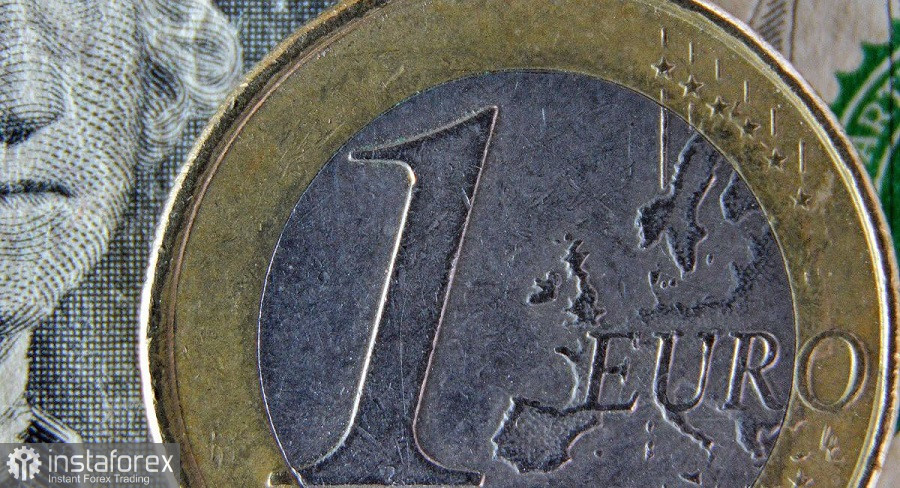Last trading week closed in favor of the EUR/USD bulls: if trading opened at 1.0537 on Monday, then the final point was set at 1.0635 on Friday. But in this case, we can only say that the bulls can claim victory because the pair was stuck within the 1.0570 - 1.0670 range. The bears were trying to consolidate within the 5th figure, while the bulls were trying to approach the limits of the 7th price level. Both sides failed - despite relatively high volatility, the price virtually stopped in the same place, within the aforementioned range.
Bulls did not meet the minimum requirement
If we look at the weekly chart, we can see that the pair showed a downtrend for four weeks (since January 29), falling from the 1.1034 high to 1.0537. However, the bears failed to build on their success: the fourth figure was too tough for them. As a result, the downtrend stalled. The bulls took the initiative but then they couldn't keep the momentum as well. The upward momentum dried up on the threshold of the 7th figure, and the pair was actually stuck between the 5th- and 6th figure.

Such background suggests that traders are now at a crossroads: to resume the downward movement the pair needs to settle below the 1.0520 target (middle line of the Bollinger Bands indicator on the 1W chart), and in order to develop the uptrend, the pair should climb above 1.0700.
Last week was mostly on the side of the bulls. US data turned out to be disappointing. The durable goods orders (including transport), consumer confidence indicator, ISM manufacturing index, the Fed Richmond manufacturing index - all these indicators came out in the red zone. While European inflation unexpectedly turned green: all components of the report were above forecasts. Moreover, last week the market was dominated by risk sentiment, also due to strong Chinese PMIs. This weighed on the US dollar, and accordingly, provided indirect support to the bulls.
But as we can see, such a unipolar fundamental background did not help the bulls to fulfill the "minimum requirement": the high of the week was marked at 1.0692. Traders could not conquer the 7th figure, although they managed to avoid falling into the area of the 5th figure.
The struggle
In my opinion, the dollar will continue to hold its ground - primarily due to increased hawkish expectations about the Federal Reserve's next actions. Recall that key inflation indicators (Consumer Price Index, Producer Price Index, Core PCE Index) reflected a slowdown in the rate of decline of US inflation. Now traders expect the Fed to respond, and not only in the context of the March meeting.
Thus, according to the CME FedWatch Tool, the probability of a 50 bps rate hike (that is, to 5.25%) at the next meeting in March is already nearly 30% (the probability of a 25 bps hike, respectively, is 70%). A few weeks ago, market participants did not even consider this option. The probability of a rate hike to 5.5% in May is now 33%, and to 5.75% in June at 25%. Moreover, a 6% final target has already appeared on the radar, although the probability of this scenario materializing by June is still estimated at 2%.
But in general, the trend is quite definite: hawkish expectations are growing as the rate of decline of US inflation slows down.
Take note that the European Central Bank has not toughened its stance in response to a similar problem in the eurozone. As mentioned above, the eurozone CPI report was in the green: the rate of decline in the overall CPI slowed, while the core index rose again, reaching a new all-time high. But in response to the data, ECB President Christine Lagarde only assured markets that the March result will reflect a more significant slowdown in inflation. She didn't toughen her rhetoric and limited herself to announcing a 50-point rate hike at the March meeting (this fact was played out at the end of the February meeting).
Conclusions
Recently, there have been alarming signals from both the eurozone and the US, indicating that inflation has started to pick up again. Nevertheless, Fed and ECB officials have reacted differently to the respective reports: members of the US central bank have mostly toughened their rhetoric, making it clear that the central bank will review the ceiling of the current monetary tightening in the upward direction. Some of them (like Bullard and Mester) supported the idea of accelerating the rate hike to 50 bps.
ECB officials, for their part, are in no hurry to "draw their swords" by stepping up the fight against inflation. Judging by Lagarde's rhetoric, ECB leaders will not trap themselves in verbal commitments, at least - until the March inflation report is released. At the moment, we can be confident about the 50-point rate hike at the next meeting, while the further pace of tightening and the size of the final rate remain a matter of debate.
Such a fundamental background does not favor the development of the EUR/USD uptrend. Last week, we observed corrections that were caused by risk sentiment in the markets and disappointing US data. The euro is still unable to organize "its own game", i.e. an independent attack within the pair. This is evidenced by the cross pairs involving the single currency (EUR/GBP and EUR/JPY, in particular).
Nonetheless, the bears need more and most importantly, powerful factors that can push the pair out of the aforementioned price range. It could be the speech of Fed Chairman Jerome Powell in the US Senate (Tuesday, March 7). Next week, the market will also focus on the February Nonfarm Payrolls report, which will be released on Friday, March 10.





















